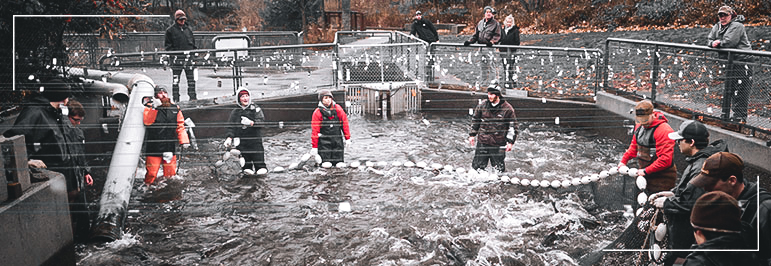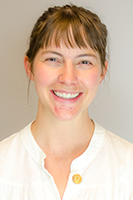Aquaculture Science

Seaweed and Mollusk Culturing Techniques - Certificate
Have you noticed more seaweed products on your grocery shelves and wondered where they came from? Did you know that Washington state leads the nation in farmed shellfish, with popular mollusks including clams, mussels, and oysters? Could you picture yourself working the low tides at an oyster farm or carefully growing new batches of algae in a shellfish hatchery? If any of these statements apply to you, then the Seaweed and Mollusk Culturing Techniques Certificate can help you explore these exciting forms of sustainable aquaculture.
Intended for students with prior college education in a related field and/or relevant work experience, this advanced level certificate skips the basics and dives straight into the technical expertise to design, operate, and sustain shellfish and seaweed cultures, with a focus on hatchery production. Course topics include live feed production of micro-algae, reproduction and fertilizing techniques for shellfish and seaweed, mollusk nutrition and health, and seed production for farming operations. Students may also customize their certificate plan with several elective courses ranging from animal genetics to aquatic chemistry to data analysis and more.
Courses are centered around the award-winning and student-operated Whatcom Creek Hatchery, which is the only college hatchery in Washington that hosts a training facility dedicated to workforce development in marine aquaculture. Students also conduct off-site training with state, industry, and tribal partners to gain experience on real working farms and other hatcheries.
Sustainable farming for domestic seafood is in high demand. Are you ready to join this growing workforce? Meet now with an academic advisor to build your customized certificate plan and get started.
Included in the AAS- Shellfish Specialization degree
Employment Information
Data are provided on a program (not credential) level
71% BTC graduate placement rate1
$49,303 starting annual wage2
$56,597 average annual wage2
$66,348 potential annual wage2
Entry Information
When Can I Start?
This program typically starts in Fall quarter.
What are the Minimum Entry Requirements?
A completed college admissions application and placement in English and Math. BTC uses a Guided Self-Placement process to help you choose the best starting point for your English and Math courses. Your selections will determine whether you begin with program coursework or complete prerequisites classes first.
To get started or for help determining your English and math placement, contact the Outreach department at Outreach@btc.edu
What are My Next Steps?
Classes
Total Program Credits: 40
Core Courses for Program
AQUA 121 Principles of Aquaculture 5 CR TOTAL Core Courses for Program Credits 5 CR Program Specialty
AQUA 222 Microalgae Culturing 2 CR AQUA 223 Shellfish Hatchery Production 2 CR AQUA 224 Shellfish and Seaweed Culture Practicum: Winter 1 CR AQUA 225 Shellfish Farm Production 5 CR AQUA 226 Shellfish Culture Practicum: Spring 1 CR AQUA 252 Aquaculture Management 5 CR AQUA 221 Seaweed Culturing 2 CR Total Program Specialty Course Credits 18 CR Electives
Elective Course (Select any from this list.) AQUA 131 Aquatic Chemistry with Lab 5 CR AQUA 141 Research Methods 3 CR AQUA 201 Aquaculture Internship I 6 CR AQUA 271 Data Analysis for Aquatic Sciences 5 CR AQUA 272 Introduction to GIS 5 CR AQUA 273 Animal Genetics with Lab 5 CR AQUA 274 Organismal Biology with Lab 5 CR BUS& 101 Introduction to Business 5 CR BUS& 201 Business Law 5 CR ECON& 201 Micro Economics 5 CR ENGR& 104 Introduction to Engineering & Design 5 CR TOTAL Elective Course Credits 17 CR
Program Outcomes
After successfully completing the certificate, students will be able to:
- Demonstrate proper shellfish, seaweed, and microalgae culturing techniques, as related to hatchery and farm production.
- Describe the form and function of commonly cultured shellfish and seaweed, as related to reproduction, growth, and health.
- Compare and contrast culturing system designs for target species.
- Conduct workplace operations in a safe and professional manner with an emphasis on teamwork skills.
Employment Outlook
Faculty & Support

Brittany Palm
Fisheries & Aquaculture Sciences
Sara Smith
Fisheries & Aquaculture Sciences
Kai Rick
Hatchery Operations Specialist
Steeve Pomerleau
Fisheries & Aquaculture
Kai Rick
Hatchery Operations Specialist
Steeve Pomerleau
Fisheries & AquacultureContacts
If you have questions about this program or want help with the admissions steps to Bellingham Technical College, please email outreach@btc.edu.
Current students wanting academic planning and support, can connect with the program Instructor(s) or email FisheriesNav@btc.edu
